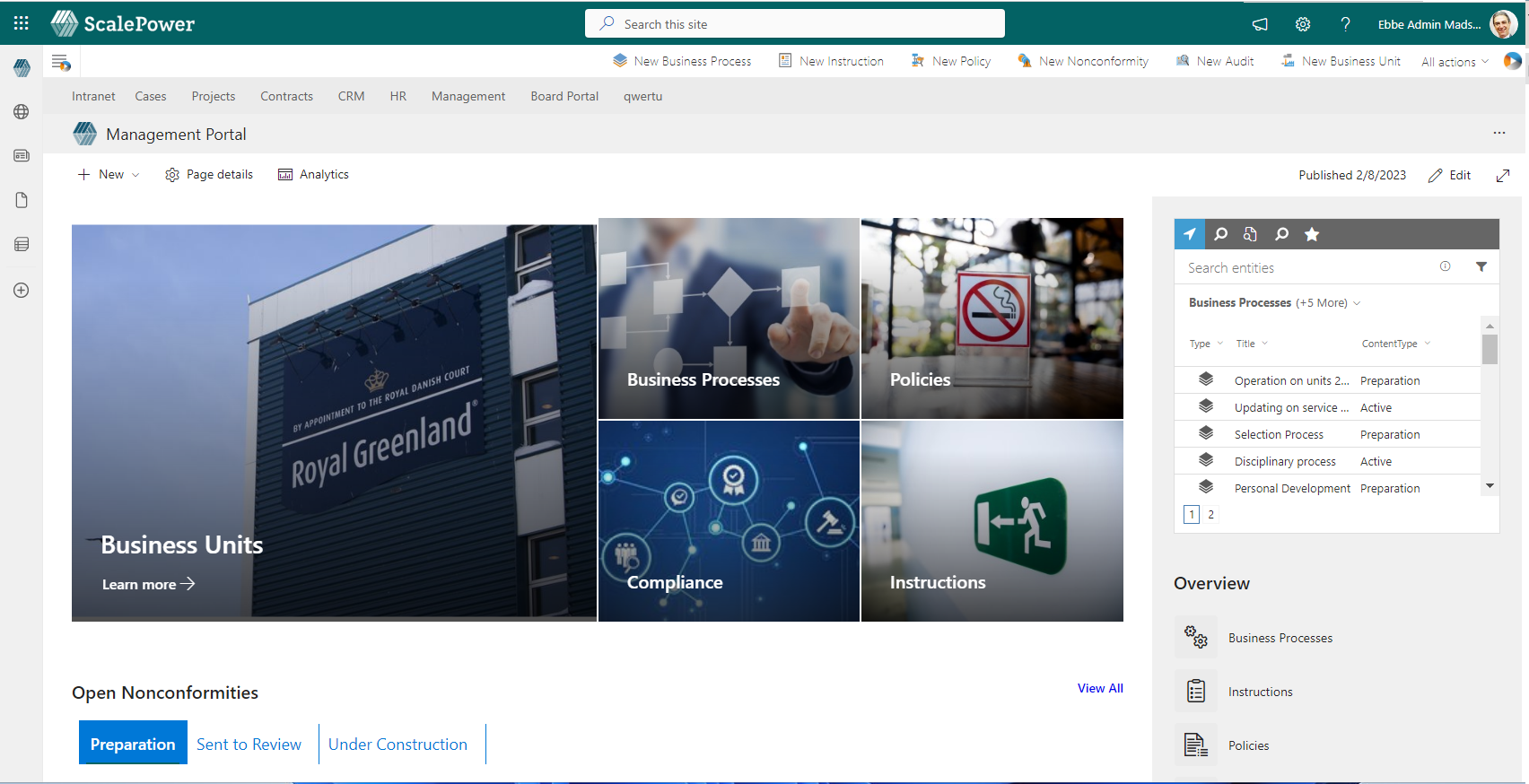QMS - Quality Management System in Microsoft 365
Quality management, quality assurance, and risk management of processes, procedures, instructions, and suppliers – NIS2 – ISO 9001, 14001, 45001, 50001
Page content: Intro > Tool Content > White Paper > Module Description > Feature Description > Highlighted Features > Contact
Page content: Intro > Tool Content > White Paper > Module Description > Feature Description > Highlighted Features > Contact
QMS – Management System in Microsoft Cloud
Standard QMS in Microsoft 365:
The management system is a standard tool in Microsoft 365 that supports a wide range of disciplines, such as:
- Risk management of processes and suppliers
- Development and management of policies and instructions
- Management, planning, and execution of audits
- Reporting and handling of deviations
- Approval processes and change management
- Alerts, alarms, and notifications
The software can be customized to support a wide range of individual workflows and methods.
QMS-løsningen konfigureres i de to bedste konfigurationsværktøjer på markedet: WorkPoint 365 og Microsoft 365 (SharePoint Online).
Easy and efficient quality assurance and management control
As a business leader, you bear great responsibility:
- You must ensure quality and customer dialogue and initiate continuous quality improvements.
- You must ensure sustainability and focus on environmental conditions and improvements.
- You must ensure a good working environment and ongoing improvements in the working environment.
- You must save energy through continuous optimization and reduction of resource and energy consumption.
- You must perform risk assessments of internal processes, customers, and suppliers and ensure that the company’s focus is on critical factors and threats.
- You must ensure physical and digital security, including cybersecurity, and anticipate threats to the company and close potential security gaps.
- You must ensure that all incidents are documented, that changes are continually updated, and that responsible parties are notified.
To take responsibility for all these areas, business leaders require an efficient and intuitive management system.
With the management system from digitalworkspace365, business leaders have an effective tool for sharing knowledge, monitoring efforts, controlling areas of focus, detecting and alerting deviations, and implementing improvements. At the same time, the organization has easy access to relevant information and the ability to perform audits, report deviations, and make improvement suggestions.
Download price list
Download price list

Get started the right way
Shorten the internal clarification process and ensure the result – and all at a fraction of the cost of a comparable tool.

Short delivery time
Get started quickly. The standard software is configured and installed on your SharePoint Online tenant in less than 30 days.

Security throughout the process
No surprises or hidden costs. You know what you get and what it costs. Predefined and transparent concept and delivery.

Easy to customize
The standard tool can be used as is or as a good starting point for a more complex business tool.

Future-proof platform
Opportunity to grow in the software. Start in one place and expand with additional business modules and features.

Subscription or fixed price - the choice is yours
Subscription – no initial costs – everything is included.
Fixed-price – tool configuration and installation included – additional purchases as needed.
The Quality Management System includes, among others:
Overview and monitoring
Overview of processes, instructions, and policies distributed across business areas and companies.
Process management
Process management and overview of progress in handling nonconformities and conducting audits, creation of processes, instructions, and policies, and compliance with deadlines.
Quality assurance
Quality assurance of workflows with built-in approval procedures, notifications, control procedures, etc.
Automation
Automation of work processes, task assignment, notifications, control efforts, approval processes, and authority notification for security breaches (NIS2 requirements).
Template center
Template center for centralized management of document and email templates.
GDPR Compliance
Effective support for compliance processes in relation to GDPR.
Employee Dashboard
Employee dashboard providing an overview of “My” processes, instructions, policies, as well as an action list with active non-conformities, audits, and “My” tasks that require action.
Risk Management
Risk management and risk overview across processes, systems, assets, and suppliers (NIS2 requirement) with a global overview and monitoring of risks across companies and business areas.
Handbook and Registration
Intuitive handbook and employee interface for registering deviations, accessing processes, instructions, policies, and self-control.
Search Function
Search function with free text search, making it easy and quick to find information and history.
Version Control
Automatic version control of documents ensures that all changes and approvals are always recorded.
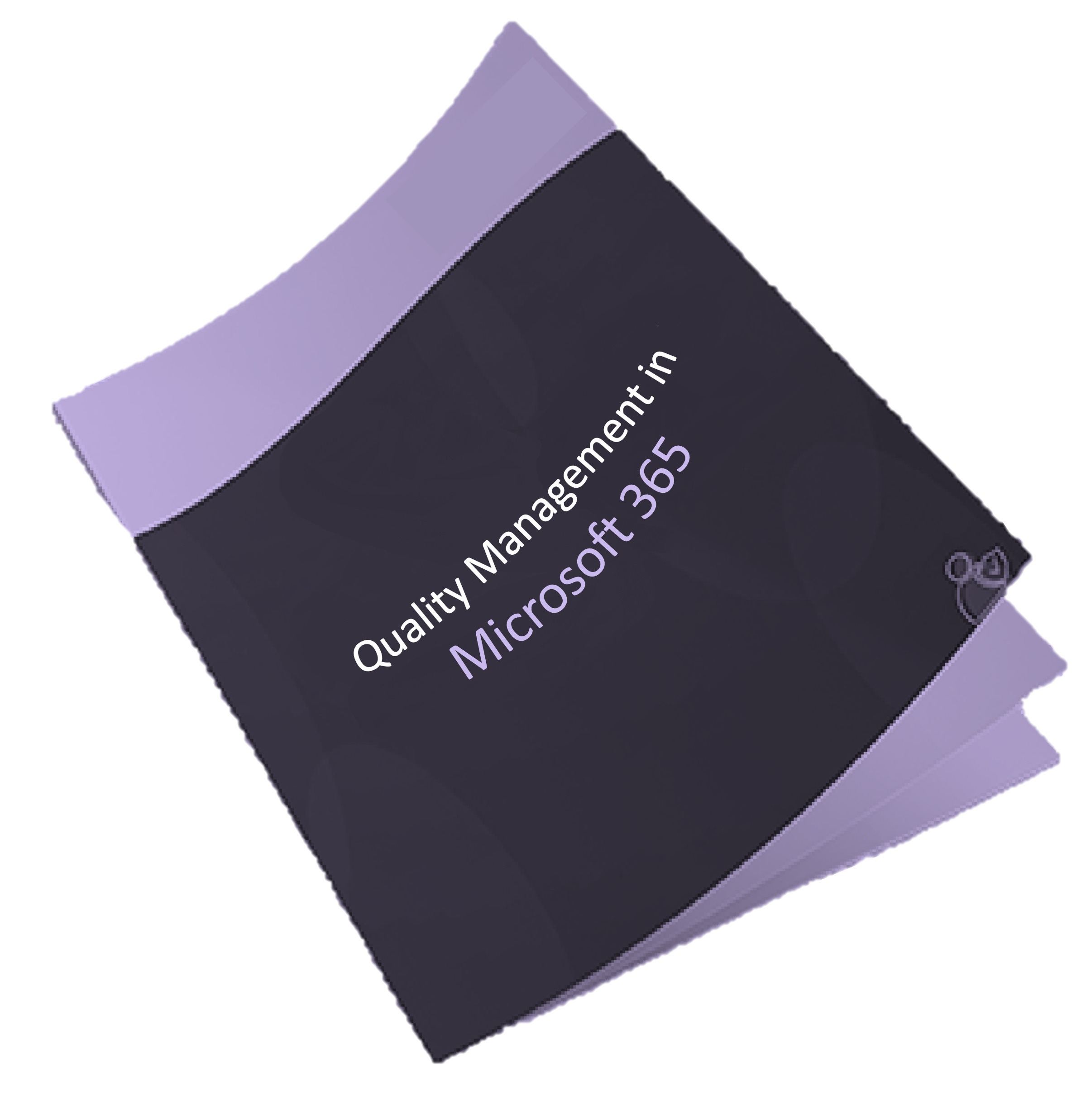
Free white paper:
Quality Management System
– a deeper dive
Download the white paper and get:
- $Introduction to the QMS tool in Microsoft 365
- $Detailed overview of the content of each main module
- $Detailed overview of the content of each add-on module
- $Screenshots from the QMS tool showing its main elements.
Quality Management System in Microsoft 365
The QMS is targeted at management and quality departments in companies actively working on quality management, quality assurance, and quality improvement of processes, procedures, instructions, and suppliers, including risk assessment, risk management, and risk overview. Typically, the Management System supports compliance with NIS2 – ISO 9001, 14001, 45001, 50001. The QMS consists of a range of standard modules and features that can be added as needed. The tool can be easily customized to individual needs.
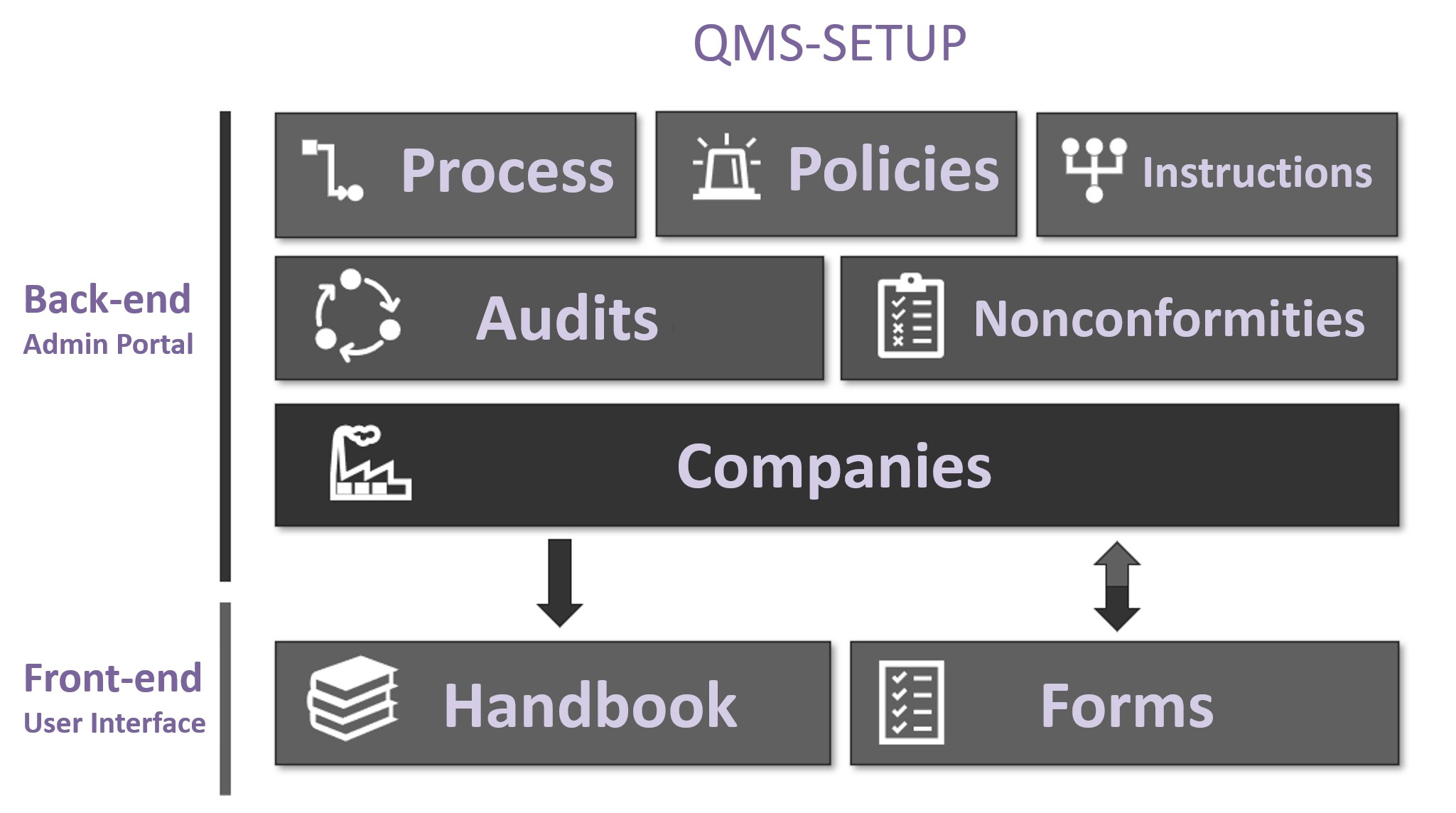
The Quality Management System consists of the following modules and features:
The Quality Management System consists of five modules:
The Quality Management System can be expanded with the following standard module:
The tool can be expanded with nine standard features:
- Task Management
- Relationship Management
- Template Management in Letter Models
- Risk Management
- Express Mail and Document Journalizing (Advanced)
- Project Power Bi Dashboard
- Handbook
- App for registering deviations and accessing instructions
- App for self-control
Quality Management System in Microsoft 365
The QMS is targeted at management and quality departments in companies actively working on quality management, quality assurance, and quality improvement of processes, procedures, instructions, and suppliers, including risk assessment, risk management, and risk overview. Typically, the Management System supports compliance with NIS2 – ISO 9001, 14001, 45001, 50001. The QMS consists of a range of standard modules and features that can be added as needed. The tool can be easily customized to individual needs.

The Quality Management System consists of the following modules and features:
The Quality Management System consists of five modules:
The Quality Management System can be expanded with the following standard module:
The tool can be expanded with nine standard features:
- Task Management
- Relationship Management
- Template Management in Letter Models
- Risk Management
- Express Mail and Document Journalizing (Advanced)
- Project Power Bi Dashboard
- Handbook
- App for registering deviations and accessing instructions
- App for self-control
Modules

Process Module
The Process module contains the company’s processes organized by business areas and/or departments. The Process module includes process descriptions as well as automation and processes for updating and maintaining them.
Read more about the content of the Process module
The Process module includes:
- Process overview page: Overview of all metadata, documents, and email correspondence related to the processes.
- Process categorization: Registration and overview of process types.
- Process status: Stage management to indicate the status of the process and manage the process cycle.
- Monitoring and alerts: Monitoring of deadlines and alerts for the process owner.
- Process overview: Overview of processes with filtering options for all registered process data.
- Process summary: Overview of contacts and process owners.
- Free text search: Retrieval of processes, documents, and emails through free text search in files such as text files, PDFs, and email content.
- Audit and nonconformity overview: Overview of audits and nonconformity reports related to the processes.
- Process diagram view: Ability to display process diagrams, e.g., in Visio.

Instruction Module
The Instruction module contains the company’s instructions organized by business areas and/or departments. The Instruction module includes instruction documents as well as automation and processes for updating and maintaining them.
Read more about the content of the Instruction module
The Instruction module includes:
- Instruction overview page: Overview of all metadata, documents, and email correspondence related to the instructions.
- Instruction categorization: Registration and overview of instruction types.
- Instruction status: Stage management to indicate the status of the instruction and manage the instruction cycle.
- Monitoring and alerts: Monitoring of deadlines and alerts for the instruction owner.
- Instruction overview: Overview of instructions with filtering options for all registered instruction data.
- Instruction summary: Overview of contacts and instruction owners.
- Free text search: Retrieval of processes, documents, and emails through free text search in files such as text files, PDFs, and email content.
- Audit and nonconformity overview: Overview of audits and nonconformity reports related to the instructions.
- Instruction App: Ability to display instructions in a self-control or operation app, optionally as an extension in a nonconformity reporting app.

Policy Module
The Policy module contains the company’s policies organized by areas. The Policy module includes policy documents as well as automation and processes for updating and maintaining them.
Read more about the content of the Policy module
The Policy module includes:
- Policy overview page: Overview of all metadata, documents, and email correspondence related to the policies.
- Policy categorization: Registration and overview of policy types.
- Policy status: Stage management to indicate the status of the policy and manage the policy cycle.
- Monitoring and alerts: Monitoring of deadlines and alerts for the policy owner.
- Policy overview: Overview of policies with filtering options for all registered policy data.
- Policy summary: Overview of contacts and policy owners.
- Free text search: Retrieval of policies, documents, and emails through free text search in files such as text files, PDFs, and email content.
- Audit and nonconformity overview: Overview of audits and nonconformity reports related to the policies.
- Handbook: Ability to display policies in an employee handbook, e.g., on the intranet.

Audit Module
The Audit module contains the company’s audits of processes, instructions, and policies. The Audit module manages audits as well as automation and processes for conducting them.
Read more about the content of the Audit module
The Audit module includes:
- Audit overview page: Overview of all metadata, documents, and email correspondence related to the audits.
- Approval procedure: Procedures for approving audits based on predefined criteria.
- Audit categorization: Registration and overview of audit types.
- Audit status: Stage management to indicate the status of audits and manage the audit cycle (planned, active, approved, and completed).
- Monitoring and notification: Monitoring of deadlines and notification to the responsible auditor.
- Audit summary: Overview of audits with filtering options for all registered audit data.
- Audit form: Form for registering audit points.
- Audit overview: Overview of contacts and audit owners.
- Free text search: Searching audits, documents, and emails through free text search in text files, PDF files, and email content.
- Yearly schedule: Ability to conduct audits at predefined intervals, such as quarterly or semi-annually.

Nonconformity module
The Nonconformity module contains the company’s reports of deviations from processes, instructions, and policies. The Nonconformity module handles reported deviations and automates processes to address them and implement changes.
Read more about the content of the nonconformity module
The Nonconformity module includes:
- Overview page: Overview of all incoming deviations, including description, metadata, documents, and email correspondence.
- Approval procedure: Procedures for approving changes based on reported deviations.
- Categorization: Registration and overview of deviation types, such as whether the deviation is critical.
- Tagging: Tagging the deviation to a specific process, instruction, or policy.
- Status: Stage management to indicate the status and manage the deviation process.
- Monitoring and notification: Monitoring of deadlines and notification to the responsible party.
- Reporting form: Form for reporting deviations.
- Deviation overview: Overview of deviations with filtering options for all registered deviation data.
- Version control: Automatic version control of documents ensures that all changes and approvals are always recorded.
- Deviation overview: Overview of contacts and reporters.
- Free text search: Searching in deviation reports, documents, and emails through free text search in text files, PDF files, and email content.
- Deviation reporting app: Ability to report deviations via an app, possibly as an extension in a self-control or operational app.

Company module
The Company module contains the companies that are part of the company. The Company module enables process management and provides an overview across the company’s entities.
Read more about the content of the company module
The Company module includes:
- Company overview page: Overview of all company entities, including registered company information (metadata), documents, and email correspondence.
- Process overview: Overview of the company’s processes.
- Instruction overview: Overview of the company’s instructions.
- Policy overview: Overview of the company’s policies.
- Company status: Stage management to indicate the company’s status.
- Company overview: Overview across companies with filtering options for all registered company information.
- Contact overview: Overview of contacts in the individual companies.
- Free text search: Searching for companies, documents, and emails through free text search in text files, PDF files, and email content.
Features
Task Management
Task management allows for the administration, control, and assignment of tasks. Task assignments can be done manually or automatically triggered by a phase shift or workflow.
Read more about the content of task management
Task management includes:
- Intuitive task panel: Displayed and used in cases, projects, contracts, etc.
- Task overview: Overview of “My tasks,” completed tasks, and ongoing tasks.
- Task status: Overview of task progress.
- Deadlines: Monitoring task execution deadlines.
- Task responsible: Overview of task responsibility.
- Automated task assignment, e.g., project creation, phase shifts during the project, or project completion.
- Role-based task assignment: Automatic assignment of tasks to individuals with a role in the case, project, customer, etc.
- Cross-project task overview: Overview of tasks across projects, cases, employees, customers, etc.
- Ability to combine task management with visual overview in a Gantt chart.
Relationship Management
Relationship management enables the creation of “one-to-many” and “many-to-many” relationships across entities. This allows for creating relationships between cases, projects, contracts, contacts, customers, suppliers, and partners.
Read more about the content of relationship management
Relationship management includes:
- Creation workflow: Intuitive workflow guiding users through the creation process.
- Two-way relationship: Relationships are automatically created as two-way relationships, registering the relationship at both ends.
- Relationship overview: Intuitive overview of relationships.
- Relationship description: Description of the nature of the relationship.
- Link: Link to the relationship for quick access to the relationship page.
Template Management in Letter Models
Template management allows for document production using text phrases (templates). Typically categorized into a header text, body text phrases, and a footer text.
Learn more about the content of template management
Template management includes:
- Template administration: Intuitive central administration of templates with an overview of templates, affiliations, and responsible parties.
- Template production: Easily create templates as Word document templates in the template administration.
- Automatic mail merge function: Metadata from the customer, case, product, or another entity is automatically inserted using Word mail merge.
- Tagging of templates: Tagging ensures that templates can be grouped and displayed only in relevant contexts.
- Intuitive wizard: Guides users through the letter production process.
- Consolidated document: Ability to compile templates into one document.
- Individual document: Ability to generate templates as standalone documents.
- Organization: Ability to select and deselect templates and customize the order.
- Customized text content: Modification and customization of text content in the created Word file.
Risk Management
The Risk Management module (Project Risk Management) provides an overview of the risk factors that may affect the project in the short and long term. Knowing the risks is necessary for effective management. The Risk Management module structures the work of identifying and defining potential risks, managing risks, and taking necessary security measures.
Read more about the content of risk management
The Risk module includes:
- Risk assessment: Work area for registering risk factors and their resulting consequences.
- Risk mapping: Rating risks based on a risk score.
- Risk matrix: Graphic visualization of risks in a risk matrix based on risk scores.
- Risk profiles: Risk management for companies and projects.
- Risk overview: Overview of risks across companies and customers with filtering options for all registered risk elements, providing a good overview of the company’s overall risks.
- Risk monitoring: Monitoring risks based on predefined risk calculations.
- Advisory: Automatic notification if the risk exceeds predefined risk threshold values.
Express Mail and Document Journalizing
Express mail and document journalizing empower the salesperson to perform 80% of sales work directly in Teams, Outlook, Word, Excel, and PowerPoint.
Read more about the content of express mail and document journalizing.
Express mail and document journalizing include:
- Direct Access to CRM tool in Teams: Work with sales cases directly in Teams.
- Express Sidebar in Outlook, Word, Excel, and PowerPoint: Provides direct access to the CRM tool in the Office programs.
- Drag and Drop: Makes it easy to journalize emails on sales cases and leads/customers.
- Search Function for retrieving sales cases, leads/customers, and contacts.
- Function for creating sales cases, leads/customers, contacts, tasks, letters, and emails from the template library.
- Other options include marking favorites, adding documents to emails, on-the-fly conversion to PDF, and much more.
Project Power BI Dashboard
The Standard Power BI Dashboard is tailored to the standard project management tool. Get a graphical overview across projects, tasks, project members, and deadlines. Click on graphs or charts to view detailed insights and correlations.
Read more about the content of the Power BI Dashboard
The Power BI Dashboard includes:
- Overview of projects and important project information.
- Overview of projects distributed by stages, project managers, months, customers, and resources.
- Overview of critical projects.
- Direct links to project sites.
- Filters for refined project views.
- Overview of active tasks and important task information.
- Overview of tasks distributed by completion status.
- Overview of personal tasks and follow-ups.
- Overview of tasks distributed by projects and stages.
- Direct links to tasks.
- Filters for refined task views.
Modules

Process Module
The Process module contains the company’s processes organized by business areas and/or departments. The Process module includes process descriptions as well as automation and processes for updating and maintaining them.
Read more about the content of the Process module
The Process module includes:
- Process overview page: Overview of all metadata, documents, and email correspondence related to the processes.
- Process categorization: Registration and overview of process types.
- Process status: Stage management to indicate the status of the process and manage the process cycle.
- Monitoring and alerts: Monitoring of deadlines and alerts for the process owner.
- Process overview: Overview of processes with filtering options for all registered process data.
- Process summary: Overview of contacts and process owners.
- Free text search: Retrieval of processes, documents, and emails through free text search in files such as text files, PDFs, and email content.
- Audit and nonconformity overview: Overview of audits and nonconformity reports related to the processes.
- Process diagram view: Ability to display process diagrams, e.g., in Visio.

Instruction Module
The Instruction module contains the company’s instructions organized by business areas and/or departments. The Instruction module includes instruction documents as well as automation and processes for updating and maintaining them.
Read more about the content of the Instruction module
The Instruction module includes:
- Instruction overview page: Overview of all metadata, documents, and email correspondence related to the instructions.
- Instruction categorization: Registration and overview of instruction types.
- Instruction status: Stage management to indicate the status of the instruction and manage the instruction cycle.
- Monitoring and alerts: Monitoring of deadlines and alerts for the instruction owner.
- Instruction overview: Overview of instructions with filtering options for all registered instruction data.
- Instruction summary: Overview of contacts and instruction owners.
- Free text search: Retrieval of processes, documents, and emails through free text search in files such as text files, PDFs, and email content.
- Audit and nonconformity overview: Overview of audits and nonconformity reports related to the instructions.
- Instruction App: Ability to display instructions in a self-control or operation app, optionally as an extension in a nonconformity reporting app.

Policy Module
The Policy module contains the company’s policies organized by areas. The Policy module includes policy documents as well as automation and processes for updating and maintaining them.
Read more about the content of the Policy module
The Policy module includes:
- Policy overview page: Overview of all metadata, documents, and email correspondence related to the policies.
- Policy categorization: Registration and overview of policy types.
- Policy status: Stage management to indicate the status of the policy and manage the policy cycle.
- Monitoring and alerts: Monitoring of deadlines and alerts for the policy owner.
- Policy overview: Overview of policies with filtering options for all registered policy data.
- Policy summary: Overview of contacts and policy owners.
- Free text search: Retrieval of policies, documents, and emails through free text search in files such as text files, PDFs, and email content.
- Audit and nonconformity overview: Overview of audits and nonconformity reports related to the policies.
- Handbook: Ability to display policies in an employee handbook, e.g., on the intranet.

Audit Module
The Audit module contains the company’s audits of processes, instructions, and policies. The Audit module manages audits as well as automation and processes for conducting them.
Read more about the content of the Audit module
The Audit module includes:
- Audit overview page: Overview of all metadata, documents, and email correspondence related to the audits.
- Approval procedure: Procedures for approving audits based on predefined criteria.
- Audit categorization: Registration and overview of audit types.
- Audit status: Stage management to indicate the status of audits and manage the audit cycle (planned, active, approved, and completed).
- Monitoring and notification: Monitoring of deadlines and notification to the responsible auditor.
- Audit summary: Overview of audits with filtering options for all registered audit data.
- Audit form: Form for registering audit points.
- Audit overview: Overview of contacts and audit owners.
- Free text search: Searching audits, documents, and emails through free text search in text files, PDF files, and email content.
- Yearly schedule: Ability to conduct audits at predefined intervals, such as quarterly or semi-annually.

Nonconformity module
The Nonconformity module contains the company’s reports of deviations from processes, instructions, and policies. The Nonconformity module handles reported deviations and automates processes to address them and implement changes.
Read more about the content of the nonconformity module
The Nonconformity module includes:
- Overview page: Overview of all incoming deviations, including description, metadata, documents, and email correspondence.
- Approval procedure: Procedures for approving changes based on reported deviations.
- Categorization: Registration and overview of deviation types, such as whether the deviation is critical.
- Tagging: Tagging the deviation to a specific process, instruction, or policy.
- Status: Stage management to indicate the status and manage the deviation process.
- Monitoring and notification: Monitoring of deadlines and notification to the responsible party.
- Reporting form: Form for reporting deviations.
- Deviation overview: Overview of deviations with filtering options for all registered deviation data.
- Version control: Automatic version control of documents ensures that all changes and approvals are always recorded.
- Deviation overview: Overview of contacts and reporters.
- Free text search: Searching in deviation reports, documents, and emails through free text search in text files, PDF files, and email content.
- Deviation reporting app: Ability to report deviations via an app, possibly as an extension in a self-control or operational app.

Company module
The Company module contains the companies that are part of the company. The Company module enables process management and provides an overview across the company’s entities.
Read more about the content of the company module
The Company module includes:
- Company overview page: Overview of all company entities, including registered company information (metadata), documents, and email correspondence.
- Process overview: Overview of the company’s processes.
- Instruction overview: Overview of the company’s instructions.
- Policy overview: Overview of the company’s policies.
- Company status: Stage management to indicate the company’s status.
- Company overview: Overview across companies with filtering options for all registered company information.
- Contact overview: Overview of contacts in the individual companies.
- Free text search: Searching for companies, documents, and emails through free text search in text files, PDF files, and email content.
Features
Task Management
Task management allows for the administration, control, and assignment of tasks. Task assignments can be done manually or automatically triggered by a phase shift or workflow.
Read more about the content of task management
Task management includes:
- Intuitive task panel: Displayed and used in cases, projects, contracts, etc.
- Task overview: Overview of “My tasks,” completed tasks, and ongoing tasks.
- Task status: Overview of task progress.
- Deadlines: Monitoring task execution deadlines.
- Task responsible: Overview of task responsibility.
- Automated task assignment, e.g., project creation, phase shifts during the project, or project completion.
- Role-based task assignment: Automatic assignment of tasks to individuals with a role in the case, project, customer, etc.
- Cross-project task overview: Overview of tasks across projects, cases, employees, customers, etc.
- Ability to combine task management with visual overview in a Gantt chart.
Relationship Management
Relationship management enables the creation of “one-to-many” and “many-to-many” relationships across entities. This allows for creating relationships between cases, projects, contracts, contacts, customers, suppliers, and partners.
Read more about the content of relationship management
Relationship management includes:
- Creation workflow: Intuitive workflow guiding users through the creation process.
- Two-way relationship: Relationships are automatically created as two-way relationships, registering the relationship at both ends.
- Relationship overview: Intuitive overview of relationships.
- Relationship description: Description of the nature of the relationship.
- Link: Link to the relationship for quick access to the relationship page.
Template Management in Letter Models
Template management allows for document production using text phrases (templates). Typically categorized into a header text, body text phrases, and a footer text.
Learn more about the content of template management
Template management includes:
- Template administration: Intuitive central administration of templates with an overview of templates, affiliations, and responsible parties.
- Template production: Easily create templates as Word document templates in the template administration.
- Automatic mail merge function: Metadata from the customer, case, product, or another entity is automatically inserted using Word mail merge.
- Tagging of templates: Tagging ensures that templates can be grouped and displayed only in relevant contexts.
- Intuitive wizard: Guides users through the letter production process.
- Consolidated document: Ability to compile templates into one document.
- Individual document: Ability to generate templates as standalone documents.
- Organization: Ability to select and deselect templates and customize the order.
- Customized text content: Modification and customization of text content in the created Word file.
Risk Management
The Risk Management module (Project Risk Management) provides an overview of the risk factors that may affect the project in the short and long term. Knowing the risks is necessary for effective management. The Risk Management module structures the work of identifying and defining potential risks, managing risks, and taking necessary security measures.
Read more about the content of risk management
The Risk module includes:
- Risk assessment: Work area for registering risk factors and their resulting consequences.
- Risk mapping: Rating risks based on a risk score.
- Risk matrix: Graphic visualization of risks in a risk matrix based on risk scores.
- Risk profiles: Risk management for companies and projects.
- Risk overview: Overview of risks across companies and customers with filtering options for all registered risk elements, providing a good overview of the company’s overall risks.
- Risk monitoring: Monitoring risks based on predefined risk calculations.
- Advisory: Automatic notification if the risk exceeds predefined risk threshold values.
Express Mail and Document Journalizing
Express mail and document journalizing empower the salesperson to perform 80% of sales work directly in Teams, Outlook, Word, Excel, and PowerPoint.
Read more about the content of express mail and document journalizing
Express mail and document journalizing include:
- Direct Access to CRM tool in Teams: Work with sales cases directly in Teams.
- Express Sidebar in Outlook, Word, Excel, and PowerPoint: Provides direct access to the CRM tool in the Office programs.
- Drag and Drop: Makes it easy to journalize emails on sales cases and leads/customers.
- Search Function for retrieving sales cases, leads/customers, and contacts.
- Function for creating sales cases, leads/customers, contacts, tasks, letters, and emails from the template library.
- Other options include marking favorites, adding documents to emails, on-the-fly conversion to PDF, and much more.
Project Power BI Dashboard
The Standard Power BI Dashboard is tailored to the standard project management tool. Get a graphical overview across projects, tasks, project members, and deadlines. Click on graphs or charts to view detailed insights and correlations.
Read more about the content of the Power BI Dashboard
The Power BI Dashboard includes:
- Overview of projects and important project information.
- Overview of projects distributed by stages, project managers, months, customers, and resources.
- Overview of critical projects.
- Direct links to project sites.
- Filters for refined project views.
- Overview of active tasks and important task information.
- Overview of tasks distributed by completion status.
- Overview of personal tasks and follow-ups.
- Overview of tasks distributed by projects and stages.
- Direct links to tasks.
- Filters for refined task views.
Highlighted features
Automation
The tool includes the ability to automate workflows and notifications. This can include automation of work processes, task assignments, notifications, control efforts, approval processes, and authority alerts for security breaches (NIS2 requirements – learn more about it here).
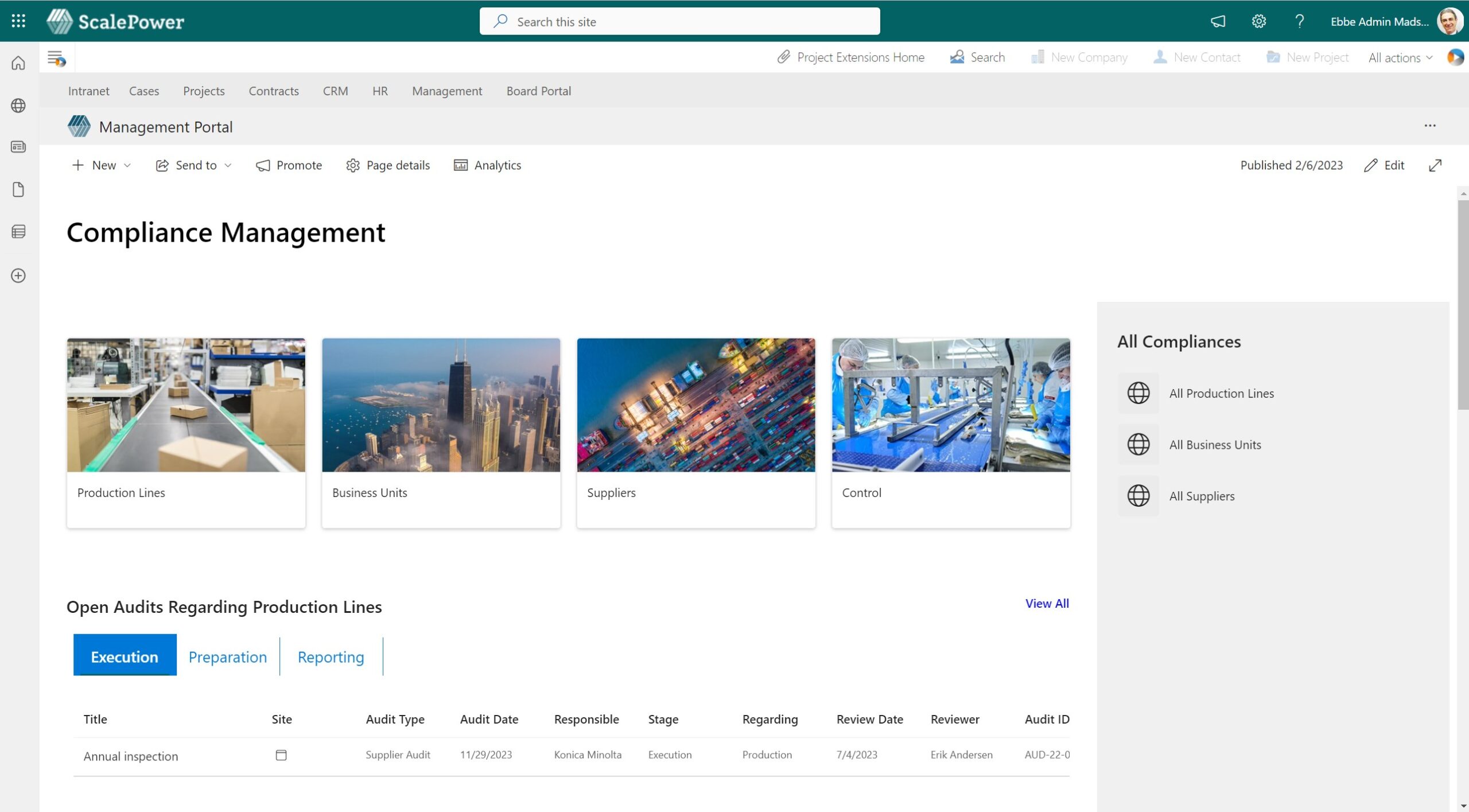
Template library
With template management, the manager can use predefined document and email templates and retrieve formulations from the template library. Templates are created and maintained in a central library. The process of creating and maintaining templates is easy and intuitive using Word’s mail merge function. Templates can be tagged to segment them according to type, so that templates are displayed only in appropriate contexts. Master data from customers/suppliers and information is automatically merged into a document or an email. If you have purchased WorkPoint Express, the template library can also be accessed from Teams, Outlook, Word, Excel, and PowerPoint.
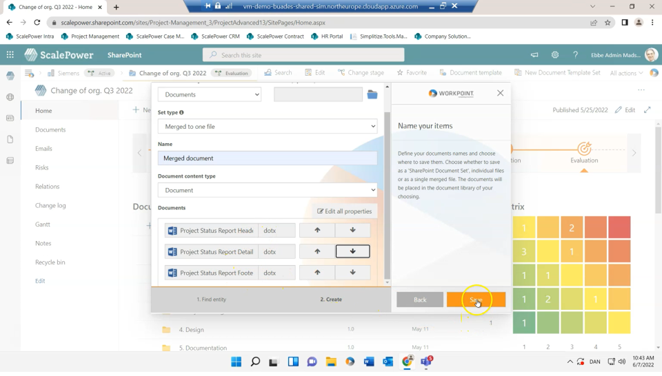
FACT BOX
- Standard software in Microsoft 365: The QMS is configured in the two best configuration tools on the market: WorkPoint 365 og Microsoft 365 (SharePoint Online).
- Work in Microsoft 365 applications: Work in Microsoft programs you know: SharePoint Online, Microsoft Teams, To-Do, Planner, Outlook, Excel, Word, and PowerPoint. And the Power Platform.
- Ownership of your own data: The QMS is a business application in SharePoint. Your data resides in your own SharePoint Online tenant. This means you have 100% ownership of your data.
- Fully scalable: The QMS operates in the Microsoft Cloud. This means that the tool does not require you to have local servers available. The tool can be scaled as needed.
- Easy access: You just need an internet connection. Then you can access the QMS through a web browser via PC, tablet, or mobile phone.
- Role-based access control to ensure compliance with the company’s security policy based on roles.
- Single sign-on: Easy and secure access control with Microsoft Authorization.
Do you need an efficient Quality Management System in Microsoft 365
– or are you just curious?
Then don’t hesitate to contact me for a non-binding conversation about the possibilities.

